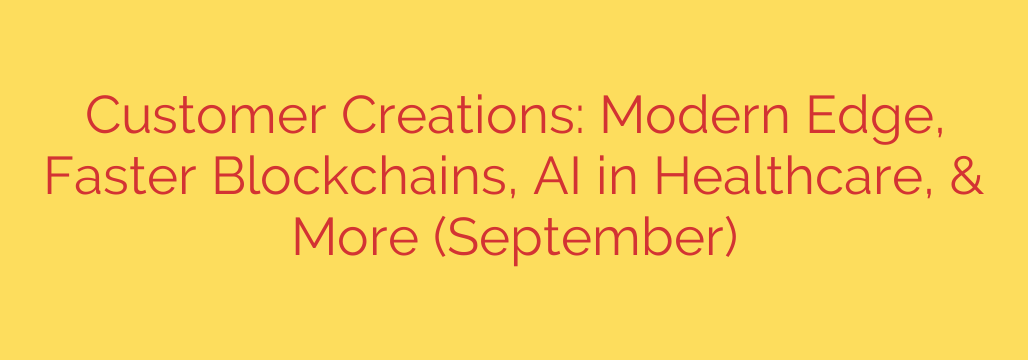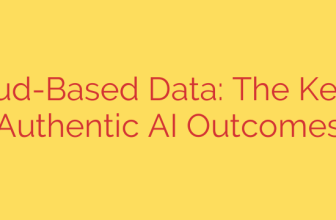
The Future is Now: How AI, Blockchain, and Edge Computing are Reshaping Industries
In today’s fast-paced digital landscape, innovation is the driving force behind meaningful change. While buzzwords like AI, blockchain, and edge computing are common, their real-world impact is often lost in technical jargon. The true story lies in how these technologies are being applied to solve complex problems, streamline operations, and create a safer, more efficient world.
Let’s explore some groundbreaking applications that are moving beyond theory and delivering tangible results across critical sectors.
AI: The New Frontier in Medical Diagnostics
The healthcare industry is on the verge of a revolution, and artificial intelligence is leading the charge. One of the most promising areas is medical diagnostics, where accuracy and speed can be life-saving. Advanced AI models are now being developed to analyze complex medical imagery, such as CT scans and X-rays, with incredible precision.
By training these systems on vast datasets of anonymized patient data, developers are creating tools that can identify subtle patterns and anomalies that might be missed by the human eye. This technology is poised to dramatically reduce diagnostic errors, delivering faster, more accurate results and improving patient outcomes. Instead of replacing medical professionals, these AI tools act as powerful assistants, enabling doctors to make more informed decisions with greater confidence.
Breaking Speed Barriers in Blockchain Technology
For years, blockchain technology has promised to revolutionize everything from finance to supply chain management with its decentralized and secure nature. However, a major roadblock has always been scalability—specifically, the slow speed of transaction processing. This limitation has prevented its widespread adoption for high-demand applications.
Now, significant progress is being made to overcome this hurdle. New blockchain protocols are being engineered from the ground up to handle a massive volume of transactions per second, rivaling traditional centralized payment systems. This leap forward makes blockchain technology viable for high-throughput applications like global finance, real-time logistics, and large-scale digital marketplaces. By solving the scalability problem, developers are unlocking the true potential of a decentralized future.
Securing the Smart World with Modern Edge Computing
The Internet of Things (IoT) has connected billions of devices to our networks, from smart home gadgets to industrial sensors. With this explosion of connectivity comes a critical security challenge: how do we protect these devices and the sensitive data they collect? The answer may lie in modern edge computing.
Edge computing involves processing data closer to where it is created, rather than sending it all to a centralized cloud. This approach has two major benefits. First, it significantly reduces latency, which is crucial for applications requiring real-time responses, like autonomous vehicles or factory automation. Second, it enhances security. By processing data locally, edge computing minimizes the amount of sensitive information transmitted over the network, reducing the attack surface for potential cyber threats. This creates a more resilient and secure framework for the entire IoT ecosystem.
Actionable Security Tips for a Connected World
As these technologies become more integrated into our business and personal lives, understanding the security implications is paramount. Whether you are a business leader, a developer, or an end-user, these principles can help you stay protected:
- Prioritize Data Encryption: Ensure that any data, whether it’s being stored or transmitted, is fully encrypted. This is your first and most important line of defense against unauthorized access.
- Implement Zero-Trust Principles: Operate on a “never trust, always verify” model. This means authenticating and authorizing every device and user before granting access to network resources, regardless of their location.
- Keep Software and Firmware Updated: Many security breaches exploit known vulnerabilities in outdated software. Regularly updating all your devices, from servers to simple IoT sensors, is a critical security practice.
- Understand Your Supply Chain: When incorporating new technology, be aware of the security practices of your vendors and partners. Your security is only as strong as the weakest link in your digital supply chain.
The Path Forward
These advancements in AI, blockchain, and edge computing are not just theoretical exercises; they are practical solutions to real-world challenges. From enhancing medical care to building a faster and more secure digital infrastructure, innovators are laying the groundwork for the next generation of technology. By focusing on tangible applications and prioritizing security, we can unlock a future that is not only smarter but also safer and more efficient for everyone.
Source: https://cloud.google.com/blog/topics/customers/cool-stuff-google-cloud-customers-built-monthly-round-up/








